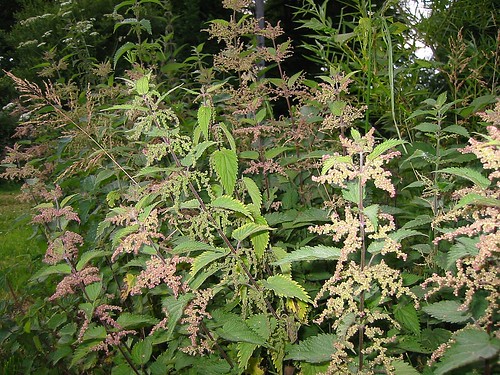
What is it?
In the UK many gardeners swear by a infusion of comfrey to feed their greedy crops in a natural and free way. Although comfrey is available in France, the French prefer to make a brew of nettles. Just like the comfrey it is understood to be full of minerals and trace nutrients combined with a hefty dose of nitrogen , phosphorus and potassium making an ideal plant food.
What is it used for?
This brew is a wonder preparation, used neat it works as an insect and weedkiller, diluted it repels insects and protects against fungal and bacterial infections, ideal for roses and other plants subject to rusts and spots. It can be used, diluted again, as a fertiliser on the roots of plants and finally, well thinned it can be applied as a foliar feed.
How do you make it?
It is, like its comfrey cousin, simplicity to make. A quantity of leaves are chopped and infused in a bucket of water for a period of fermentation, the pulp is strained out and the tea is ready for use.
To make 10 litres you will need 1 to 1.5 kgs of fresh nettles. Get the leafiest growth you can, stems and seed heads are less effective. If you're making a large quantity it's worth laying them out on a flat service and running the lawn mower over them to shred and collect them conveniently but smaller amounts can be chopped by shears or scissors in well gloved hands.
If you possibly can use rain or stream water, if not allow tap water to sit for 24 hours in an open bucket to allow chlorine to disperse.
Mix your chopped nettles with the water in a non-metallic container that can be covered. This is mainly to contain the smell that will develop as the process continues but it also discourages flies which will want to lay eggs. Give everything a good stir, cover and leave for period of days for fermentation to take place. This will be between 7 and 28 days depending on the ambient temperature but 15 days is usually considered adequate. You can check fermentation has finished by holding your nose and giving the soup a stir. Any fizzing or bubbles means that you need to leave it a bit longer.
When the bubbling has ceased it's ready to be strained off the pulp for the next stage. If you're not going to use it immediately then you should bottle it in plastic bottles and keep it in the cool and dim for a few months. If you want to preserve it longer or cannot find a cool shed then it can be frozen but not many people have a quarantine freezer or would want to mix this with the frozen peas.
Put the used pulp in the compost.
How do you use it?
To kill aphids use it within 12 hours of the fermentation ceasing, at full strength. Strain again through a fine mesh or your sprayer will clog and apply while the sun is not burning down, in the morning or evening. Use with caution and don't spray too liberally, some authorities suggest it will act as an effective herbicide at this concentration if applied generously. It can also be used at full strength as an activator for compost heaps or septic tanks.
Diluted at a ratio of 1:5 with clean water it makes a good soil preparation feed, applied to beds before planting.
At a ratio of 1:10 it can be used as a weekly feed on the soil of tomatoes, potatoes and other solanums like aubergines. These sorts of plants do not respond well to foliar feeding. Make sure the plants have adequate fresh water as well, nettle tea applied to roots that are dying of thirst will likely kill them. At this dilution of 10% it is also reputed to repel aphids and cure fungal infections when sprayed on ornamental plants.
Foliar feeds on well watered plants should be at 1:20 or even milder. Regular spraying is more effective but the more frequently it is applied the weaker the solution should be. This applies to all feeding routines, since the plants can only take up a certain amount of nutrients in any given time and excess will just build up in the soil or on the leaves and cause problems.
Other tips.
To stop the pulp from clogging water containers with taps use old jute potato sacks or plastic bags with holes punched in them weighted with a brick and tied at the top. A string handle is a good idea too. Strain the pulp through a similar arrangement to avoid contaminating kitchen equipment. For fine straining for sprayers old tights are effective.
Nettles are often only too easy to find but remember they are the preferred food plants of a number of our loveliest butterfly caterpillars so harvest judiciously and try to share with nature.
Nettles can be dried for use at other times of the year. Cut them and lay out to dry in a shaded airy place, ideally on netting so that the air can circulate. Crumble down into paper sacks and store in the dry. You will need about 100g dry weight per 10 litres of water.
In France it is possible to buy nettle concentrate to make instant feed. This is still available in the shops despite some difficulties with horticultural legislation and the EU. Nobody wants to give this up.
Nettles and comfrey can be used for humans too, make a weak tea with fresh or dried leaves mixed with a little of your favourite tea for flavour and sip throughout the day. Good for arthritis and general health.
No comments:
Post a Comment